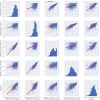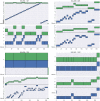Evaluating Hierarchical Structure in Music Annotations
- PMID: 28824514
- PMCID: PMC5541043
- DOI: 10.3389/fpsyg.2017.01337
Evaluating Hierarchical Structure in Music Annotations
Abstract
Music exhibits structure at multiple scales, ranging from motifs to large-scale functional components. When inferring the structure of a piece, different listeners may attend to different temporal scales, which can result in disagreements when they describe the same piece. In the field of music informatics research (MIR), it is common to use corpora annotated with structural boundaries at different levels. By quantifying disagreements between multiple annotators, previous research has yielded several insights relevant to the study of music cognition. First, annotators tend to agree when structural boundaries are ambiguous. Second, this ambiguity seems to depend on musical features, time scale, and genre. Furthermore, it is possible to tune current annotation evaluation metrics to better align with these perceptual differences. However, previous work has not directly analyzed the effects of hierarchical structure because the existing methods for comparing structural annotations are designed for "flat" descriptions, and do not readily generalize to hierarchical annotations. In this paper, we extend and generalize previous work on the evaluation of hierarchical descriptions of musical structure. We derive an evaluation metric which can compare hierarchical annotations holistically across multiple levels. sing this metric, we investigate inter-annotator agreement on the multilevel annotations of two different music corpora, investigate the influence of acoustic properties on hierarchical annotations, and evaluate existing hierarchical segmentation algorithms against the distribution of inter-annotator agreement.
Keywords: evaluation; hierarchy; inter-annotator agreement; music structure.
Figures











References
-
- Balke S., Arifi-Müller V., Lamprecht L., Müller M. (2016). Retrieving audio recordings using musical themes, in Proceedings of the IEEE International Conference on Acoustics, Speech, and Signal Processing (ICASSP) (Shanghai: ).
-
- Barwick L. (1989). Creative (ir) regularities: the intermeshing of text and melody in performance of central australian song. Aus. Aboriginal Stud. 1, 12–28.
-
- Bruderer M. J. (2008). Perception and Modeling of Segment Boundaries in Popular Music. PhD thesis, Doctoral dissertation, JF Schouten School for User-System Interaction Research, Technische Universiteit Eindhoven.
-
- Clayton M. (1997). Le mètre et le tāl dans la musique de l'inde du nord. Cahiers Musiques Traditionnelles 10, 169–189. 10.2307/40240271 - DOI
LinkOut - more resources
Full Text Sources
Other Literature Sources

